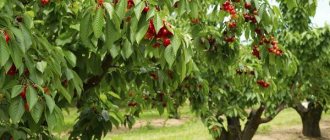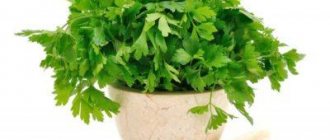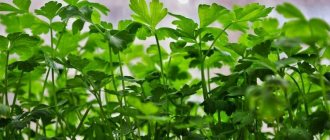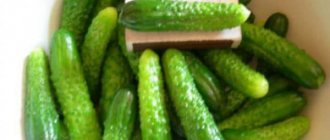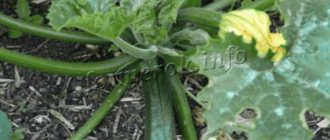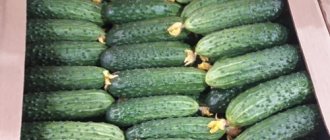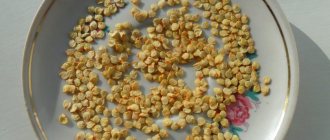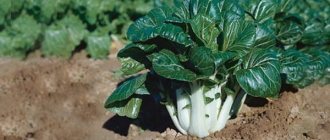Which parsley is called root parsley?
Root parsley is a biennial plant.
The height of the above-ground part can reach a length of 100 cm. It is represented by straight branching stems covered with bright green, dissected leaves. They are tougher than the leaf varieties. They are used for preparing hot dishes. The underground part is a thickened root with a cone shape. It is formed in the first year of life. The average length of the root crop is 20-30 cm. The skin is white-brown, white or white-yellow. The pulp is white or cream-colored, dense, aromatic.
The plant of the second year of life throws out a peduncle in June-July. Its height is 70-150 cm. An umbrella inflorescence is formed on it, consisting of small, yellow-white flowers. After flowering, fruits are formed. They are dark, oblong, flattened laterally.
Application
Root parsley is used in home cooking, cosmetology, medicine, and dietary nutrition. The root vegetable contains a complex of useful substances. In addition to proteins, fats and carbohydrates, they contain vitamins (A, E, C, B), mineral salts, organic acids, and dietary fiber.
Cooks value parsley root for its original bittersweet taste. The pulp of the root vegetable goes well with fish, meat, and vegetables. It is eaten raw, added to vegetable and fruit salads, seasoned in soups, added to stews, and used as a spicy seasoning in homemade preparations.
Benefits and harms
Regular consumption of parsley root improves vision. It is positively influenced by carotene contained in the pulp. Dietary fiber normalizes stool and stimulates intestinal function. Vitamin C strengthens overall immunity.
Root parsley is widely used in folk medicine. Decoctions and infusions are prepared on its basis. They are used internally or externally. There are contraindications. Eating the root vegetable fresh and using it for medicinal purposes is not recommended for people with the following pathologies:
- stomach ulcer (during periods of exacerbation);
- cystitis;
- nephritis.
Comment! Pregnant women are not recommended to use root parsley. The substances that make up the pulp affect the muscles of the uterus.
| Recipe No. | Ingredients | Quantity | Cooking time | Purpose |
| 1 | Chopped, dry roots | 1 tbsp. l | 30 minutes | From excess gas formation |
| Boiling water | 200 ml | |||
| 2 | Chopped, dry roots | 50 g | 30 minutes | Rub into scalp to strengthen hair |
| Boiling water | 300 ml | |||
| 3 | Juice | 15 ml | Mix before use, drink before meals | To cleanse blood vessels and improve heart function |
| Water | 100 ml |
The following beneficial properties of infusions, decoctions and fresh roots of sweet parsley have been tested in practice:
- normalize the menstrual cycle;
- strengthen men's health;
- serve as prostatitis prevention;
- cleanse the liver;
- remove toxins from the body;
- normalize acidity;
- serve as a prevention of osteoporosis;
- reduce swelling.
Benefits and harms
Root parsley has a lot of beneficial properties:
May be interesting Greens on the windowsill all year round Processing onion sets before planting, myths and reality Growing delicious bell peppers at home
- a large amount of vitamins (A, C, E, K, B) and microelements (iron, calcium, zinc, copper, phosphorus);
- content of myristicin, limoment and eugenol;
- improving the condition of patients suffering from diabetes;
- removal of uric acid with systematic consumption of roots in food;
- treatment of toothache, insect bites, prostatitis;
- liver cleansing due to the removal of toxins;
- providing a beneficial effect on the spine;
- preventing osteoporosis;
- restoration of the menstrual cycle.
Parsley can only cause harm under several conditions - pregnancy, cystitis or neuritis.
Varieties of root parsley
Early-ripening, mid-ripening and late-ripening varieties of spicy crops are grown in the garden and summer cottage. The most popular of them:
- Sugar. An early ripening variety, it has a ripening period of about one hundred days after germination. It produces a harvest only in the second year. The fruits are grayish in color with yellow flesh. The crop yield is 3 kg per 1 m².
- Eagle Representative of mid-early varieties. Bred in Holland. The root crops have a compact shape and weight 120-130 g. The average yield is 2 kg per 1 m². The variety is intended for fresh consumption, processing and long-term storage.
- Harvest (pictured). Has good taste. Underground fruits with white and crispy pulp, reaching a weight of 70-90 g. The variety is highly resistant to low temperatures. Used in fresh, dried and frozen forms.
- The final. A mid-season variety with large root crops, the weight reaches 200 g. Ripening time is 130 days after germination. The average yield is 2 kg per 1 m². Shelf life is average.
- Spicy. Medium ripening variety. Mass harvesting of root crops begins 120-130 days after germination. It has a pleasant aroma and good taste. The root vegetable is conical in shape, weighs 100 g. Suitable for fresh consumption and storage.
- Alba. A late-ripening variety, ripening 170-180 days after the sprouts appear. Gives a high yield. From 1 m² you get up to 5 kg of root vegetables with white aromatic pulp and excellent taste. The fruits are stored for a long time. They are eaten raw and canned.
Application of medicinal properties in folk medicine
The healing properties of the root have been known for so long that during this time hundreds and hundreds of traditional medicine recipes using parsley root have appeared. Here are the most famous of them:
For cystitis and kidney spasms
To prepare the decoction you will need:
- 1 large or 4 small roots.
- 500 ml water.
Preparation:
- Cut the skin off the roots.
- Chop them finely.
- Throw into water and boil.
- After boiling, keep on low heat for another third of an hour.
- Leave the resulting broth for 10 hours.
- Strain after this time.
Application : The decoction is taken once daily, 200 ml on an empty stomach, continue for 3-4 days.
Attention! Drinking the decoction may cause sand to come out.
We invite you to watch an informative video with another recipe for cystitis using parsley root:
For prostatitis
Will be needed:
- A small parsley root.
- 100 ml water.
Preparation:
- Finely chop the root, filling one teaspoon with it.
- Boil water, add finely chopped root to it.
- Leave to infuse overnight.
- Strain in the morning.
Application : 15 ml of infusion are taken 4 times a day half an hour before meals. Continue taking until you feel better.
Read about when you should take parsley infusion and how to make it here.
Features of growing root parsley
Gardeners who grow leaf parsley can also cope with root parsley. But it is necessary to take into account the peculiarities of culture:
- The root crop prefers loose, breathable soils;
- to obtain even underground fruits, agricultural techniques should be followed (watering, fertilizing, loosening);
- the root seasoning is cultivated in a garden bed, in a greenhouse, or on a windowsill (for forcing greens in winter).
Seed producers offer enough planting material. The following varieties of aromatic root vegetables are popular among gardeners:
- Productive (root length up to 20 cm, demonstrates resistance to diseases and pests);
- Alba (grows up to 290 g, has no fine hairs on the main root, is perfectly stored);
- Final (the root (underground) part grows up to 200 g, the fruits are leveled, the delicate taste is revealed in preservation);
- Sugar (valued for the early ripening of the root part, grows up to 60 g, grayish-white color, sweet taste).
- Eagle (Dutch variety, root crops are aligned, grows up to 140 g, valued for high yield and universal use of roots).
When purchasing seeds, gardeners evaluate ripening time, root yield, taste and use options.
Description of the plant and the best varieties
Root parsley is a cold-resistant, biennial plant from the Apiaceae family. In cooking, the roots are often used, since the leaves have a weak taste and aroma; in folk medicine, all parts of the plant, including the seeds, are used. The stem is straight, branching. The leaves are collected in rosettes, they are dark green, smooth, strongly dissected. The fruit is thickened, conical or spindle-shaped.
On a note!
Typically, root parsley blooms only in the second year after planting, extremely rarely in the first season.
The period from germination to harvest depends on the variety. In the second decade of summer, the plant produces a peduncle from 60 to 150 cm in height; the flowers are small, yellow-green, collected in complex umbels. The seeds ripen gradually from late summer to late autumn, the grains are oblong, compressed on the sides, dark brown or black, sometimes with lighter stripes or inclusions. We will describe the 3 most common varieties.
Alba
A variety resistant to negative weather factors, parasites and diseases. It ripens in the mid-late period; the period from the emergence of seedlings to the start of harvesting root crops lasts approximately 95–120 days. Alba can be planted in moderately shaded areas, but only in fertile, light soil. The variety does not tolerate waterlogged soils; it is better to avoid cultivating the crop in lowlands or organize drainage.
The rosette is powerful, produces no more than 15 large, dark green, fragrant leaves. The roots are elongated triangular with a smooth surface and are not prone to branching. When canned, the fruit does not darken. The skin is white-yellow, the flesh is creamy-white, homogeneous, crispy, juicy, very tasty with a rich, pleasant aroma. Root vegetables are 20–15 cm long, weighing from 100 to 125 g.
Parsley root Sugar
It is acceptable to grow in regions with cool and short summers; in such conditions, the grains need to be germinated. An early ripening variety, resistant to diseases and pests, develops well in open areas and in partial shade. No more than 105 days pass from full germination to harvest. Seeds can be sown in early spring, mid-summer and before winter.
The rosette is powerful, dense, forms up to 40 dark green, large leaves with a shiny surface, the greens have a rather weak aroma, and are quite tough. The root vegetable is conical with a pointed tip, up to 30 cm in length, the diameter of the fruit at the rosette is about 4–7 cm. The skin of the root is grayish-white, the flesh is white, the core has a faint yellow tint. Sugar is called the most delicious root variety. The fruits are from 80 to 100 g, very juicy and aromatic.
Harvest
A variety that is resistant to all unfavorable factors and consistently produces high yields. It ripens in an average period, no more than 130 days pass from germination to harvest. The plant is biennial; greens are harvested in the first year, and root vegetables in the second season. The rosette is semi-spreading, forms from 11 to 20 dark green, large leaves with a glossy surface. The root is conical with a sharp tip, the skin is gray-white, the flesh is white, the core is light yellow. The weight of the root crop is 20–40 g, length is from 20 to 30 cm. The taste and aroma of greens and fruits are excellent.
Attention!
In cool regions, it is permissible to sow medium, mid-late and late varieties in early spring and before winter; during summer planting, the roots will not ripen until the first autumn frosts.
It is also worth paying attention to such varieties as Final, Tops and Roots, Eagle, Good Morning, Berlinia, Atika, Doctor, Konica. The varieties described are suitable for fresh use, processing and storage (by any means). To harvest root parsley from mid-summer to late autumn, you need to plant several species that ripen at different times.
Features of planting root parsley
The technology of crop cultivation has its own characteristics. It is successfully grown in closed, open ground and in apartments. The harvest depends on the quality of the soil and the level of lighting. To prevent diseases in the garden, it is necessary to observe crop rotation. In greenhouses, replace the soil once every 2 years.
Landing dates
Root parsley is sown in open ground in spring and late autumn. The culture is resistant to low temperatures. In spring, seeds are sown early, while the soil is moist - March, April. The soil should warm up by only 4 °C. In the fall, plant dry seeds 2-2.5 weeks before the onset of frost. The ridge is made earlier, while the days are warm.
Planting parsley
When to plant parsley
Do not complicate your life by growing parsley seedlings, although under certain conditions this method of propagation is justified; it is better to grow it from seeds without seedlings. Sowing parsley in open ground is carried out in the second half of April or in the fall, from the second half of October. In order to have it fresh for the table all summer, leaf parsley can be sown in a conveyor method - every two weeks until the end of July.
Choose a site for the crop that is well-lit, with light, loose, fertile and not too wet soil. Light loams and sandy loams with a hydrogen index of 6.5-7.0 units are most suitable for parsley. It is not advisable to sow parsley in a place where the groundwater is too high. If on your site they lie close to the surface, you can make high beds for parsley.
Good predecessors for the crop are onions, tomatoes, zucchini and squash, potatoes, cabbage and cucumbers.
Do not grow parsley after Umbrella plants (carrots, parsley, celery, fennel, coriander, dill and others), but together with them - please: parsley and dill, parsley and carrots, parsley and cilantro, and so on can grow in the same bed at the same time .
Parsley grows well in the same area with legumes, cucumbers and tomatoes.
How to plant parsley
Planting parsley in the spring requires advance preparation of the site, which is carried out in the fall. If you sow parsley in the fall, prepare the soil for the crop at least two to three weeks before sowing.
Growing fodder parsley requires adding manure to the soil, but not before sowing parsley, but a year before it, before growing the predecessor crop. Green parsley (leaf), on the contrary, grows well on manure. It is applied in the fall for digging in the amount of 4-5 kg per m². Instead of manure, you can use compost in the same quantities. In addition to organic matter, complex mineral fertilizer is applied to poor soil, but this is done in the spring, immediately before planting. If you are planning to sow parsley before winter, then add mineral fertilizers to the soil along with manure or compost.
Since dry parsley seeds germinate slowly, soak them in water for half an hour and then dry them so that they crumble rather than stick to your hands. Make grooves in the bed 1-1.5 cm deep at a distance of half a meter from one another, pour them well with warm water, and when it is absorbed, sow seeds in them, fill the grooves with soil and compact it. Parsley usually sprouts in two to three weeks. Pre-winter sowing is carried out with dry seeds, after which the bed is mulched with peat or humus.
Sowing parsley before winter
Root parsley can be sown before winter. With this we provide ourselves with an early, friendly harvest of root crops and free up the hot spring time. Many people ask the question: when to sow parsley before winter? Sowing must be done at a stable negative temperature. In the fall, we make furrows in the beds and prepare soil or sand for backfilling. In winter, we place seeds in the prepared grooves and cover them with loose substrate. We fill it with snow on top.
Root parsley is convenient to use in winter for distilling vitamin greens. To do this, we plant root vegetables in high containers, leaving about two centimeters above the surface. Water it and place it on the windowsill. Soon our pot will turn green and provide our family with delicious seasoning.
Selecting a location
What does root parsley look like?
Choosing a location is a fairly important step when growing parsley. And it must meet certain criteria. Soil that is well loosened works well, as it conducts oxygen to the root system. The best options would be soddy-podzolic, super sandy and moderate loamy soil.
The place where the parsley will grow should be well lit by sunlight. If there is any shading, the branches will develop poorly. And as a result, the parsley will be small in size and lose its sweetness in taste.
A heated place is not suitable for parsley. Since such microflora very often becomes infected with fungus and rot. With high moisture and dampness, the root system of the soil begins to slowly rot, spreading to all the roots. And in this case the plant dies.
The landing site must be protected from strong winds and drafts. It would be good if there was a small building next to the place that would limit the plant from the winds, but not block it from the sun's rays.
Plants that grew earlier also greatly influence the development of parsley. If carrots or celery grew in this place, then such a place is not suitable. When growing the remaining crops, the parsley will develop perfectly.
Note: The site for planting must be prepared before planting. When planting in spring, you need to prepare the soil in autumn. If planting is carried out in winter, then 40 days before planting.
Features of care
To grow a good harvest, you need to know the planting features and rules for caring for root parsley.
Advice! To germinate, root parsley seeds are soaked for 4 days in warm water. The water is renewed every day.
During the summer, the ridge is watered, the soil is loosened, weeds are regularly removed, the plants are thinned out, and treated for pests and diseases.
Watering rules
The bed with root parsley is watered in the morning or in the evening. Water is poured at the root. The sprinkling method is not used. In wet weather, stop watering or reduce its frequency. The maximum need for moisture occurs in August. At this time, the approximate water consumption is 20 l/m².
Top dressing
It is necessary to care for root parsley all summer. After the first thinning, the parsley is fed with an infusion of grass or mullein, diluted with water in a ratio of 1:10. The next time they water it with a solution of mineral fertilizers after the second thinning.
Dissolve in a bucket of water:
- potassium salt – 50 g;
- ammonium nitrate – 10 g.
The third time they feed with ash. It is scattered over the ridge after watering. Consumption – 1 st/m².
Thinning
When thinning, you should only get rid of weak and flaccid shoots. Strong and healthy shoots should remain on the ridge. After all, this is the only way they will develop well and produce a good harvest in the future.
Thinning should be done for the first time after the sprouts appear. Between each crop you need to leave about 2.5 centimeters. The next thinning should be carried out 2 weeks after the first. It is during this thinning that strong plants can be identified, which are left. With this thinning, the distance between plants increases to 7 centimeters.
Loosening and weeding
The soil must be promptly cleared of weeds and various debris that is in the soil. The first cleaning should be carried out to a depth of 4-5 centimeters. And the next cleaning will affect increasingly lower layers of soil, reaching up to 18 centimeters.
Along with harvesting, it is necessary to loosen the soil. Gardeners want to start loosening as early as possible, so they begin to add other seeds to the parsley planting material, which will act as beacons. That is, for 10 parsley seeds add 1-2 mustard or lettuce seeds.
These beacons are needed in order to find out when it is already possible to loosen. After these beacons sprout, you need to loosen the soil.
It is also necessary to loosen the soil after each watering or rain to ensure the supply of oxygen to the root system.
When to harvest root parsley?
Root parsley: photo
It is customary to collect root parsley at the end of September; by this time the root parsley is fully ripe. Although the collection depends only on the region where the parsley grows. In warm areas, full ripening occurs earlier than in cold areas.
Growing parsley in open ground from seeds
Parsley is great for growing outdoors. Sowing can be done several times per season. The seeds of this spicy herb germinate in 20-25 days, but there is a way to speed up this process with special treatment before planting.
Preparing seeds for sowing
It is better to take planting material not fresh, but with the harvest date last year before last - they have more growth energy.
In order for parsley to sprout faster, the seeds are first prepared for sowing. To do this, soak them in warm water, which is changed every 4-5 hours. After two or three days, the seeds are placed in a growth stimulator for 24 hours.
There are other ways to speed up germination:
- 2-3 weeks before planting, the seeds are placed in a cotton bag and buried in the ground to a depth of 20-30 cm. Before sowing, they are dried on paper until they begin to crumble in the hands. This method will allow you to get the first shoots already on the fifth day;
- soaking in vodka. Ethyl dissolves esters well on seeds, which prevent moisture penetration. For this method, you need to pour vodka into a saucer and place the seeds there, previously wrapped in gauze. Be sure to take out the planting material after 15-20 minutes and wash it well in running water. Otherwise, the seeds may burn. After drying, you can begin planting;
- soaking using ash. Place 2 tablespoons of ash in a 1-liter jar and fill it with water slightly above room temperature. The solution is stirred from time to time, after 2 days the seeds are placed inside the jar in a gauze knot for 5 hours.
If parsley is needed for sale in large quantities, it is recommended to force germination.
This is done like this:
- seeds are soaked in milk 2 hours before planting;
- apply quicklime in moderate quantities into the furrow;
- moistened seeds are placed in a bed and sprinkled with water;
- The furrows are filled in and the soil is lightly compacted.
Shoots may appear as early as the next day.
Planting scheme
It is convenient to plant parsley in grooves no more than 2 cm deep. Sowing can be done in a continuous line, but then thinning will be necessary. This can be avoided by immediately planting the seeds 7-18 cm apart depending on the variety.
Before filling the seeds, the grooves are spilled with water. Then, they are covered with soil and watered again.
After the first leaves, the seedlings are thinned out. The gaps are left at 3 cm. After 10-16 days, the parsley is pulled out, leaving a gap of 10-15 cm. At the same time, all the greens removed from the beds are successfully eaten.
Timing for planting seeds
For greenery to germinate, a temperature of 20-24 degrees is needed. Therefore, it is recommended to cover the soil with film after sowing. In this case, you need to ventilate the planting and raise the shelter for a short time.
You can sow parsley before winter. Then the seeds are planted in the beds in the second half of October and before the first frost, insulating the crops on top with peat. Additionally, later planting is sprinkled with snow. With the arrival of spring, already at a temperature of 4 degrees, the sprouts begin to move. At this time, you can cover the future harvest with film.
Care during cultivation
After the first appearance of greenery on the surface of the soil, the film must be removed to give more light to the seedlings. At the same time, the greens will not freeze, because they can withstand up to 9 degrees of frost.
For a bountiful harvest, follow simple care rules:
- Thin out the first shoots so that there is 18 cm between leaf varieties and 7-15 cm between root varieties.
- for a continuous harvest, seeds are sown once every 1-2 weeks;
- Be sure to loosen heavy soil;
- Weed control will help the crop grow strong and healthy.
It has been noticed that the taste of parsley depends on the timeliness of watering. The crop has bright and juicy leaves if it received enough water throughout its growth. To grow greens for further drying, you need to limit watering. This way, the seasoning will be more aromatic, although the leaves will become tougher.
Watering and fertilizing
Fertilizing is carried out together with watering. It is enough to apply fertilizer once or twice a season. Saltpeter is suitable (5-7 grams per 1 square meter). You can add a nitrogen supplement in the same amount.
At the beginning of growth, root parsley needs complex fertilizers; closer to autumn, phosphorus and potassium fertilizers are ideal. They are prepared according to this recipe: 7 grams of superphosphate is mixed with 5 grams of potassium salt. The mixture is enough for 1 square. meter of soil.
Growing root parsley for seeds
To get root parsley seeds yourself, for the next season in early May, plant 3-4 of the best root crops (specially selected for seeds, well developed and not branched) into the soil. Their top, the so-called hangers, should be at ground level. The distance between root crops should be no less than 40 cm. Such a bed must also be weeded, the soil on it loosened, watered and fed. After 35-45 days, the flowering period begins. Collect the ripe seeds, dry, grind, winnow and then store in textile bags until the next season.
Recommendations for growing parsley
1. Plants planted around the perimeter of the area where other vegetables are planted will save them from the invasion of slugs;
2. Thanks to the beautiful leaves, parsley can look great in garden flowerpots or boxes on the balcony with flowers growing in them;
3. To preserve fresh parsley leaves longer, dip them in a solution of table vinegar diluted in half with water for 0.5 hours;
4. Although parsley is not a moisture-loving crop, in very dry and hot summers the growth of its leaves is delayed and they become coarser. But at the same time, the leaves accumulate more essential oils and become much more fragrant;
5. At the end of the season, dig up a few bushes, plant them in pots, take them to your apartment, so you can please your family with fresh herbs in winter.
Fight against enemies
If you know what diseases and pests can affect root parsley, then it will be much easier for you to prevent their development and eliminate them at an early stage of damage. Most often, parsley is affected by the following diseases:
- White rot . This disease is concentrated on the surface of the plant. If the lesion grows, sclerotia of the fungus are formed. As a result, the plant tissue becomes soft and the roots rot.
- Downy mildew . This disease is concentrated on the leaves. First, chlorotic inclusions form on them, and then they turn into yellow spots.
- Rust . Parsley produces a rusty tint. This disease forms in early summer. If you do not provide assistance to the affected crop in time, the leaves and stem turn brown.
- White spotting . This disease makes itself felt by the damage to the lower leaves, stems and cuttings. You will find pale spots with a yellowish tint on them. At first they are small in size, but over time the spot grows and can completely affect the entire leaf. Numerous pycnidia are formed on damaged tissues.
- Cercospora leaf blight . The disease affects leaves, stems and umbels. The disease manifests itself in the form of spots that have an angular, rounded shape. The spots are yellow or dirty brown in color.
- Carrot psyllid . This insect has a light green color. Its larvae are greenish-yellow in color. Adults and larvae use plant sap for their nutrition.
- Carrot flour . Plants affected by this insect are stunted in growth, their leaves have a reddish-purple color. As a result, the foliage then turns yellow and falls off.
- Stem nematode . It most often attacks onions and garlic, but today many gardeners have begun to notice that the insect is not averse to eating root parsley. Adults and larvae use plant sap for their nutrition.
- Melon aphid . This pest is located below on the leaves, flowers and stem. Insects feed on parsley juice. The affected crop begins to shrink, turn yellow and dry out.
In the video - root parsley:
Growing root parsley is a simple process. It is fashionable to produce it in two ways: seedlings or seeds. It is worth choosing the appropriate option taking into account the climatic characteristics of your region. Caring for this crop is also simple; it is important to ensure timely watering, loosening and pest control.
Possible diseases of parsley root
During the growing season, symptoms of diseases can be seen on the leaves. The most common:
- white spotting;
- rust;
- peronosporosis;
- white rot;
- cercospora blight
| Symptoms | Disease |
| Yellow, chlorotic spots on leaves | Downy mildew |
| Light spots on the bottom of the cuttings and leaves | White spot |
| Yellow or brown spots on leaves that are round or striped | Cercospora |
| Rusty spots appear at the beginning of summer | Rust |
| White coating on the top of the plant, the root crop is rotting | White rot |
The causes of the disease are excessive watering, dense planting, lack of light, and failure to observe crop rotation.
Pests
Root parsley is attacked by melon aphids and carrot flies. The greatest damage is caused by carrot psyllid larvae. They parasitize the upper part of the root. For prevention, the bed is sprinkled with ash mixed with tobacco dust in a 1:1 ratio.
When aphids appear, wash parsley leaves with a soap-ash solution or infusion of onion peels. The treatment is repeated every 3 days. To repel carrot flies, plants are sprayed with water and kerosene is added to it. Pour 1 tbsp into 1 liter. l means.
Features of root system growth
Zinnia - description, best varieties, annual or perennial
After the seed is placed in the soil, it begins to develop and germinate. In the first year, the crop produces abundant greenery from the rosette. The root develops in the ground. It looks like a spindle. The root system of parsley in the first year of growing season is very developed, regardless of what type of crop is grown in the garden.
Important! The root system of parsley has the property of vertical geotropism. In simple words, the root system can grow and expand in only one direction - strictly downward. Therefore, to the question “what organ of parsley grows downwards all summer?” the answer is simple - it is the root.
In the second year of vegetative development, parsley grows a root crop. It is formed from the lower part of the stem and the main root. The root crop has the shape of a cone. It tapers towards the bottom.
In the second year, leaf parsley continues to develop a powerful root system, but it does not transform into a root crop.
In the second year, all the necessary substances accumulate in the roots, and at the end of June the crop should bloom. Umbrellas appear on the stem. On each one you can see a large number of flowers of the same color. Each flower is yellow in color with an emerald tint. Culture can decorate a garden. After 50-60 days, brown seeds form on the umbrellas, which are later used for planting.
Flowering plant
If we talk about how many times parsley bears fruit in its life, then the answer is clear. The crop can produce fruits once - they are formed in the second year of the growing season. Parsley grows in one place for 2 years.
Additional Information. It is believed that parsley acquired its name thanks to the Greeks. They named the plant "petros", which translates as stone. This spicy herb grows wild in Greece. It can be seen on the rocky shores of the Mediterranean Sea.
Harvest and storage
Parsley is not afraid of cold weather, so it is harvested in late autumn. Choose a dry, sunny day. Root crops are dug up with a pitchfork and pulled out of the ground. The greens are cut off, leaving a small stump. The harvest is stored under a canopy for drying. After 1-2 days they are put into processing or sent for storage.
In winter, root parsley is stored at a temperature of 0-2 °C. in a cellar or utility room. Maintain high air humidity - 85-90%. Root crops are placed in boxes in layers, sprinkled with sand. The vegetable compartment of the refrigerator is suitable for long-term storage. In it, parsley is stored in plastic bags.
Most housewives prefer to harvest root parsley for future use. Two methods are used:
- drying;
- freezing.
Dry the peeled and chopped root vegetable in an oven or in an electric dryer. Store in a glass container with an airtight lid. To freeze, the roots are peeled, washed, cut into slices or cubes, placed in plastic bags and placed in the freezer.
Root vegetables can be left in the ground for the winter. This is one of the popular ways to store crops. The above-ground part is cut off. The ridge is covered with a layer of river sand and covered with film. In winter they throw snow on it. Planting root parsley is easy. Caring for and growing root parsley takes a minimum of time. A harvest of high-quality root crops is easy to grow on a well-prepared bed, seasoned with mineral and organic fertilizers. Late varieties of root parsley lie in the cellar until spring. Early and mid-season varieties are dried or quickly frozen. Regular consumption of the root vegetable has a positive effect on health and appearance.
Growing parsley in open ground from root vegetables
A fast and reliable method that does not require time for seed germination. For roots to grow, it is necessary to create favorable conditions and proper care.
Planting parsley in the ground
The strongest and healthiest roots are selected for planting. Their thickness ranges from 2 to 5 cm, the permissible length is no more than 8 cm. Too long specimens can be shortened with a knife blade. In this case, the cut is treated with charcoal. Root vegetables should be smooth without tops. Before planting, they are kept at a temperature of +2 degrees in the sand.
When to plant parsley
You can start planting in open ground from April to June.
How to plant parsley
For planting, it is better to choose sunny places with shade. The soil must be sufficiently drained; if this is not the case, then sand must be added to it.
In the selected area, make narrow furrows at intervals of 15-16 cm and water them with water. The roots are removed from the sand and laid on the beds in rows at an angle of 45 degrees. There should be a distance of 5 cm between the crops. When falling asleep on the surface, the tip of the root should stick out 2 cm. Afterwards, the earth is compacted and spilled with plenty of water.
Caring for parsley in the ground
In order for plantings to take root, the temperature must be kept at least 15 degrees. After emergence, the leaves are regularly sprayed with water. Mature greens 25 cm high can be cut. The soil must be constantly loosened to allow oxygen to reach the roots. Weeds that take away beneficial substances from the crop must be destroyed in a timely manner.
Watering and fertilizing
Root parsley loves watering, which should be done before the end of August. If the summer is hot, essential oils accumulate under the heat. Greens exude a more intense aroma, but the taste suffers and the shoots turn out rough. Therefore, special attention should be paid to watering during drought. In rainy summers, parsley may have a weak aroma, but the leaves are tender and soft.
With proper planting and care techniques, the first harvest is harvested within 30 days.
Collection and storage of parsley
For fresh consumption, parsley is collected from the beds as needed. For short-term storage, use a refrigerator and special bags for vegetables. After cutting the greenery from the socket, after a while a new seasoning grows. The roots of the crop are collected before the onset of frost, when the temperature is below 5 degrees. Harvested crops are stored less at higher temperatures.
To make the leaves of the plant more fragrant, you need to sharply reduce watering in 8-15 days.
For long-term storage, greens can be dried. To do this, the leaves are collected in dry weather during the day when the dew has just disappeared. It is advisable that the plant has not yet bloomed.
Only strong and green shoots are chosen. After washing, the leaves are laid out on paper.
To dry root vegetables, they are first washed well, the outer thin skin is peeled off and cut into thin circles or strips. Parsley is dried in air, in the oven or in special devices. Whole root vegetables are stored in sand in basements.
Salt serves as a good preservative for parsley as well. The greens are cut or torn into pieces and poured into jars along with salt. The workpiece is compacted well. It makes an excellent addition to salads, the main thing is not to add extra salt to the dish.
Green seasoning can also be frozen. To do this, strong shoots are washed, slightly dried and placed in bags or containers for freezing.
You can make an excellent salad dressing by chopping the greens and compacting them into a jar. Then pour refined oil on top of everything so that it covers all the greens. This dressing should be stored in the refrigerator.
Getting parsley seeds yourself
A crop that is grown for its seeds is called a seed plant. The soil for growing them does not have to be very fertile. Thus, the growth period will increase, and the seeds will not have time to ripen. The testes must be healthy, without defects or deformity.
To prevent cross-pollination, leaf and root parsley should be planted away from each other.
In the fall, the healthiest and most beautiful roots are selected and stored at a temperature of 0-2 degrees in a container with sand. In spring, planting material is thoroughly inspected and rotten or wilted specimens are thrown away. The remaining roots are transferred to a warmer room, where after some time shoots form on them. Then the seeds are planted in the beds. All summer they are cared for like ordinary parsley. Flowering will occur in 40-43 days. Further, it will take 120-130 days for the seeds to ripen.
The collected seeds are sorted and stored in a ventilated, shaded place, away from sunlight. It is unacceptable to dry planting material in the oven.
Afterwards, the seeds are placed in jars or paper bags. Store in a room with an air temperature of no more than 5 degrees. A suitable place is a cellar or refrigerator door. You should monitor humidity; if it is high, the germination rate of planting material will decrease.
With proper storage standards, seeds can remain viable for two to four years.
How to store root parsley at home
Storing root parsley after harvesting is carried out in several ways:
- Dry sand. Immediately after harvesting, the root crops are sorted, laid out in wooden boxes and sprinkled with sand so that they do not touch each other. The containers are placed in the cellar at a temperature of 0-2 °C and the preparations are periodically checked throughout the winter, promptly removing rotten or dried fruits.
- Freezing. You can store root parsley in the freezer. First, the fruits are washed and blanched in boiling water for about five minutes, and then dried and cut into circles or strips. The raw materials are laid out in plastic bags and the air is removed from them, and then the workpiece is put into the freezer.
- Drying. The washed and peeled roots are cut and placed in the oven at a temperature of about 60 °C for 3-4 hours. When the slices become crispy and brittle, they will need to be packaged in clean jars or fabric bags and stored in a dry, dark place.
When storing root parsley at home in the cellar and freezer, the root vegetables retain their nutritional properties for up to six months. In dried form, they can be consumed for up to two years.
Dried parsley is good for use as a seasoning in soups and side dishes.
